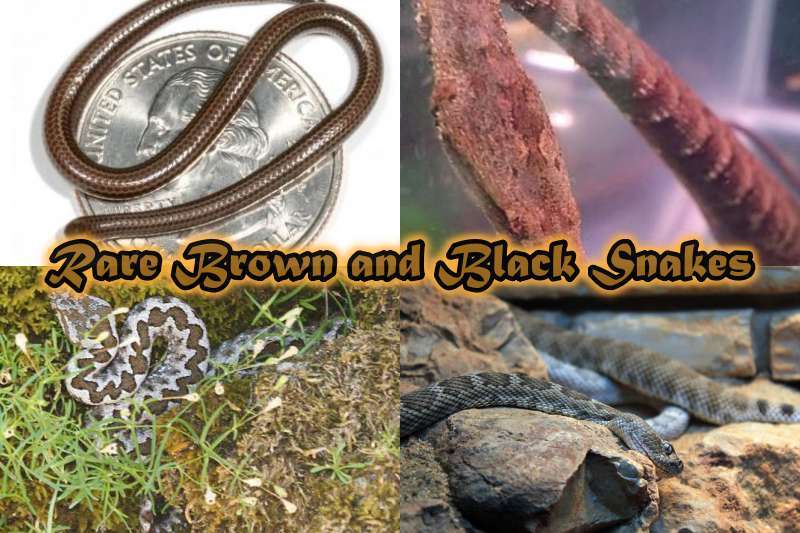Snakes are abundant in our environment and are a fascinating group of creatures. Their wide range of species has astounding variety, from deadly venomous to decidedly harmless, from pitch black to bright red. Some are easier to find than others, and some are in a critical position nearing extinction. This time, we’ve taken this interesting topic and made a list of the 20 rarest brown and black snakes worldwide. Let’s see how that looks.
Rarest Brown and Black Snakes Worldwide
1) Short Nosed Sea Snake
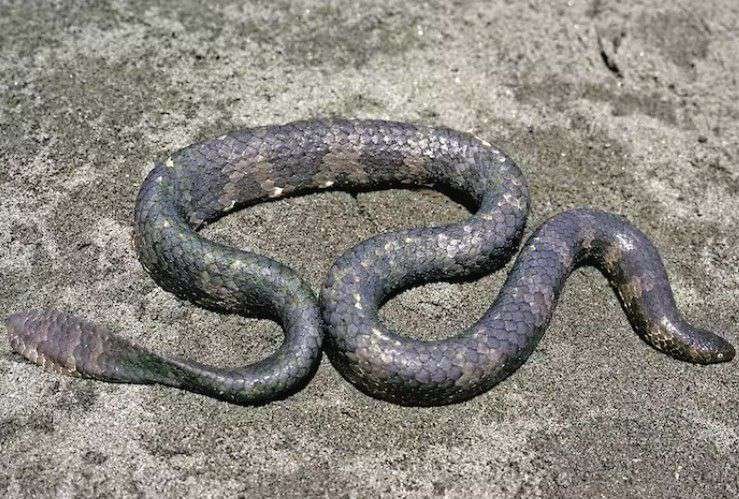
Short Nosed Sea Snakes, as their name implies, are marine species of snakes with distinctively small and pointed heads. This species is venomous and native to northwestern Australia. The snake has a long but slender body that is broader in the middle. Its skin color is a combination of beige and dark brown.
Short nosed sea snakes are currently facing a population decline due to the massive pollution in the water. Garbage and water spilling into the ocean are threatening this already rare species and can be critical in their extinction soon.
- Common Names: Sahul Reef Snake
- Scientific name: Aipysurus apraefrontalis
- Size: 60 centimeters (24 inches)
- Location: Ashmore and Cartier Islands, and the Ningaloo Reef along the coast of Northwestern Australia
2) Albany Adder
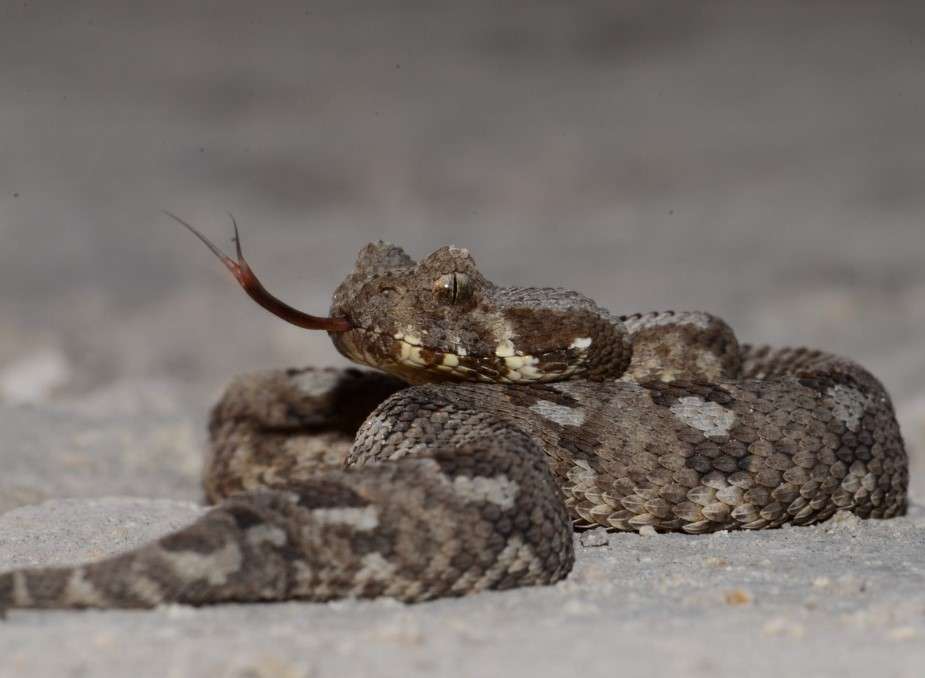
Albany Adder is one the snake species that are extremely rare to find. Up to a point, they were considered to be extinct until five specimens were found in 2016, though one of them was roadkill. As of yet, only 12 specimens of this species have been found, which is very concerning.
The Albany Adder’s coloration ranges from brown to reddish brown with darker splotches on its back. The snake lacks the horns characteristic of its nominate race, but they have prominent bumps over their eyes. This species of snake is also very venomous.
- Scientific name: Bitis albanica
- Size: males- 27 centimeters (11 inches), females- 22.5 centimeters (8.9 inches)
- Location: Eastern and southern Cape Province in South Africa
3) Alcatraz Lancehead
Alcatraz Lancehead is a species of pit viper and thus is extremely venomous. In fact, they are considered one of the most dangerous snakes in the world. They are endemic to Alcatraz Island, and IUCN has listed them as vulnerable.
They are a small species of snakes with considerably large eyes. The color of their skin includes black, beige, and light brown. At some point, Alcatraz Lanceheads faced a significant decline in food and, over time, shrunk in size due to a process known as allopatric speciation.
- Scientific name: Bothrops alcatraz
- Size: males- 46.2 centimeters, females- 50.5 centimeters
- Location: Ilha Alcatrazes off the coast of São Paulo in southeastern Brazil
4) Darevsky’s Viper
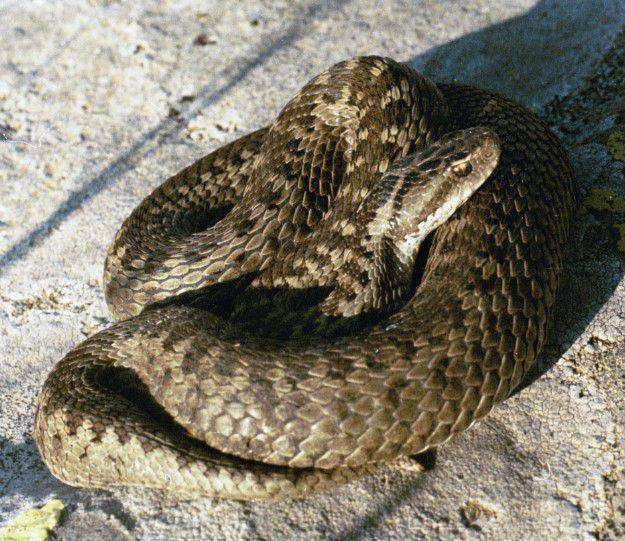
Darevsky’s Viper is a venomous viper species. Their venom isn’t lethal to adult humans, but the bite is painful and can cause local swelling. They are small in size, and their skin has light brown or gray as the background color, with black and discontinuous zigzag patterns on its back. It also has a pattern of black or gray dots on its belly.
According to the IUCN Red List of Threatened Species, Darevsky’s Viper is facing a population decline which may get even worse. Their habitat is also suffering, and in the coming years, finding a specimen of this rare snake species will be difficult.
- Scientific name: Vipera darevskii
- Size: males- 16 inches, females- 10.2 inches
- Location: Northeastern Turkey, northwestern Armenia, southern Georgia
5) Round Island Boa
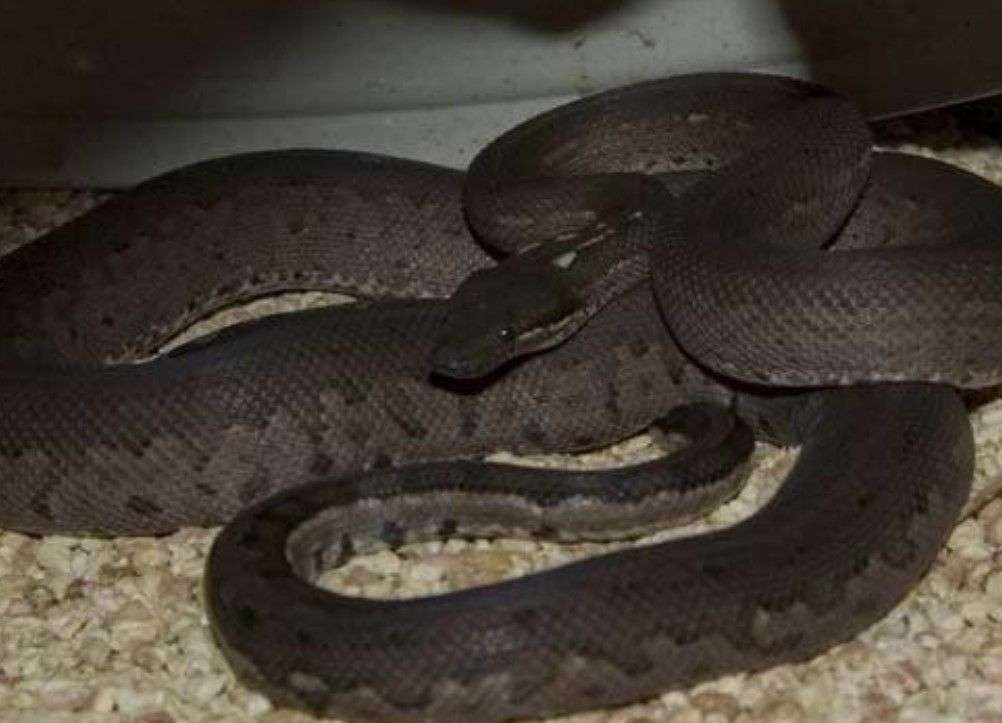
Round Island Boa is a rare species of boa endemic to the Round Island of Mauritius. This nonvenomous snake has a slender body with a dark brown back and a light-colored belly covered with dark spots. This snake species is covered by keel scales and has split jaws.
IUCN has classified Round Island Boa as Endangered on their Red List. This means while they are not currently under the threat of extinction, that may change in the future with their small population. That earns the Round Island Boa a spot on our list of rare brown and black snakes worldwide.
- Common Name: Round Island Keel-scaled Boa, Round Island Ground Boa
- Scientific name: Casarea dussumieri
- Size: 150 centimeters (5 feet)
- Location: Round Island, islands of Gunner’s Quoin, Flat Island, Ile de la Pas and mainland Mauritius
6) Saint Vincent Blacksnake
Saint Vincent Blacksnake is a terrestrial species only found in North America. The body of this snake is slender and has a black dorsal side and a light-colored ventral side. This species of snake wraps itself around a branch of a tree and attacks its prey by camouflaging itself on the branch.
Saint Vincent Blacksnake is categorized as Critically Endangered as their natural habitat is quickly being destroyed, and as a result, their numbers are fast declining.
- Common Name: Saint Vincent Coachwhip, Saint Vincent Racer, Vincent’s Sipo
- Scientific name: Chironius vincenti
- Size: 40 inches (3.29 feet)
- Location: Saint Vincent and Grenadines
7) St. Lucia Racer Snake
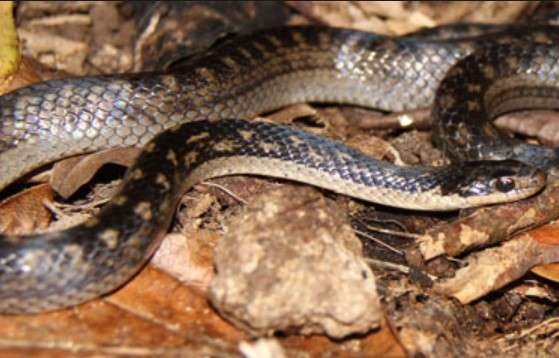
St. Lucia Racer is considered to be the rarest snake on the planet. They are only found in the island nation Saint Lucia of the West Indies in the Caribbean Sea.
The coloration of the nonvenomous snake is variable, ranging from black to light brown. Some snakes of this species have dark brown stripes on their backs, while some have yellow spots all over them.
For a very long time, scientists had considered this particular species to be extinct until 11 specimens were found in 2012. Their small numbers can be the result of habitat destruction as well as predation from mongooses. Currently, they are considered to be critically endangered species.
- Common Names: Ornate Ground Snake
- Scientific name: Erythrolamprus ornatus
- Size: 123.5 centimeters (48.6 inches)
- Location: Saint Lucia, West Indies in the eastern Caribbean Sea
8) Ross’ Wolf Snake
Ross’ Wolf Snake is the next on this list of rare brown and black snakes worldwide. This species of snake is terrestrial and belongs to the Colubridae Family, the largest family of snakes. They are dark brown dorsally with ivory-yellow bellies. Another notable part of them is their eyes which have circular pupils.
Very little is known about this species because of the lack of specimens. This is a Critically Endangered species, according to the IUCN Red List, and needs to be conserved to save them from extinction.
- Scientific name: Lycodon chrysoprateros
- Size: 72.7 centimeters
- Location: Dalupiri Island in Philippines
9) Barbados Threadsnake
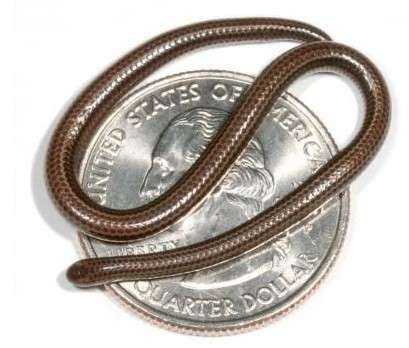
Barbados Threadsnakes are the smallest known snake species in the world. They are very small, almost worm-like in appearance, with their average length of the adult body being only 10 centimeters. The highest length observed in them is 10.4 centimeters.
Barbados Threadsnakes are very rare, and thus little is known about their habitat and ecology. They are native to Barbados, where forests are fast declining, posing a problem for small creatures. Their numbers have taken a hit with the rapid deforestation in Barbados and are considered to be endangered.
- Scientific name: Tetracheilostoma carlae
- Size: 10 centimeters (3.94 inches)
- Location: Caribbean Islands of Barbados and Anguilla
10) Dragon Snake
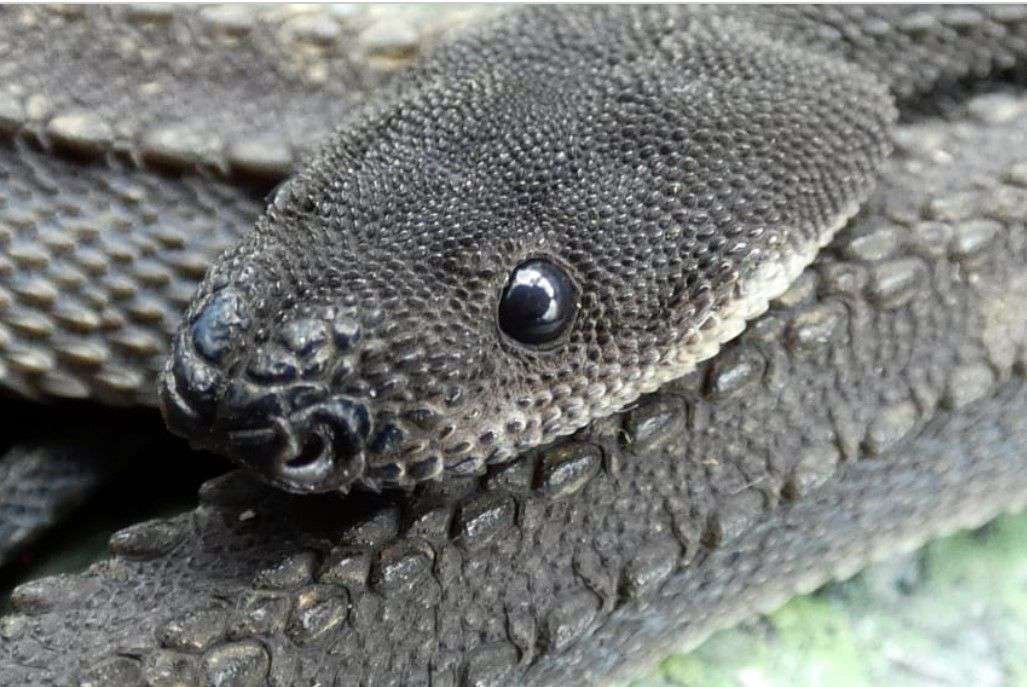
Dragon Snakes are a species of beautifully unique snakes popular for their mythical look. These snakes are non-venomous and known for their characteristic black dorsal scales, which give them a dragon-like appearance.
Dragon Snakes have an interesting defense mechanism where they stiffen their bodies under perceived threat.
Dragon Snakes are pretty rare, and their population is not currently under any imminent threat. But there are assumptions that their numbers could be threatened by agricultural pollutants.
- Common Names: Javan Tubercle Snake, Javan Mudsnake, Rough-backed Litter Snake
- Scientific name: Xenodermus javanicus
- Size: 50 centimeters (20 inches)
- Location: Malaysia, Thailand, parts of Greater Sunda Islands (Sumatra, Java, Borneo and some smaller islands) and southernmost tip of Myanmar
11) Tancitaran Dusky Rattlesnake
Tancitaran Dusky Rattlesnake is one of the pit viper species and is very venomous. The color of their skin differs from one another, ranging from gray to brown, with darker colored spots covering the entirety of their body. These rattlesnakes are active during the day and lay low at night due to the low temperature of their habitat.
Tancitaran Dusky Rattlesnakes are found in only five locations which indicates a low number for the species. Scientists consider them to face a high risk of extinction in the wild. Thus, IUCN has listed the snake species as Endangered.
- Scientific name: Crotalus pusillus
- Size: 50 centimeters (20 inches)
- Location: West-central Mexico
12) Santa Catalina Island Rattlesnake

Like the previous entry on our list of rare black and brown snakes worldwide, Santa Catalina Rattlesnake is also from the pit viper family and is venomous.
The snakes of this species are considerably long, reaching up to 2.4 feet in adults. They have a very light brown or beige as their base skin color with brown spots along their body.
Santa Catalina Island Rattlesnakes are endemic to Isla Santa Catalina and are facing a major popular decline since it was assessed in 2007. The cause for their decreasing number is because of the predators like domestic cats and the collection of snakes done by humans. Because of this, the species is classified as Critically Endangered on IUCN Red List.
- Scientific name: Crotalus catalinensis
- Size: 73.1 centimeters (2.4 feet)
- Location: Isla Santa Catalina in the Gulf of California off the east coast of Baja California Sur, Mexico
13) Elephant Trunk Snake
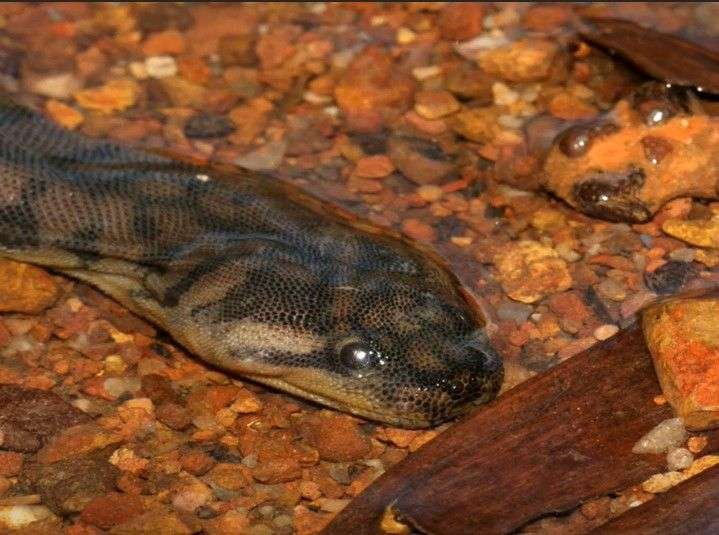
Elephant Trunk Snakes are a species of aquatic snakes with very distinct looks. The dorsal side of their body is brown, and their belly is pale yellow. Their skin is loose and baggy, looking as if it is a bigger fit than necessary.
The non-venomous snakes are adapted to live underwater and have trouble on the land, being hardly able to move and injuring themselves in the process.
Elephant Trunk Snakes are not endangered and spread across quite a large area worldwide, but they are still hard to come across and are thus rare to find.
- Common Names: Javan File Snake
- Scientific name: Acrochordus javanicus
- Size: 2.4 meters (94 inches)
- Location: Southern Thailand, west coast of Peninsular Malaysia, Singapore, Borneo, some Indonesian islands like Java and Sumatra and possibly Bali, Cambodia
14) Tentacled Snake

Tentacled Snakes are a species of small snakes native to South Asia. Its name comes from the twin tentacle-like protrusions on the front of its head. These “tentacles” act as mechanosensory receptors.
The tentacled snake has venomous fangs that they use on fish, which are their primary diet. But its venom is not dangerous to humans.
The tentacled snake is slender and has black colored skin with light brown splotches on them. This snake has an interesting ability where it retracts its eyes when it’s striking its prey. Its numbers are as of yet stable, but that can soon change due to habitat destruction.
- Common Names: Tentacle Snake
- Scientific name: Erpeton tentaculatum
- Size: 50 – 90 centimeters (20 – 35 inches)
- Location: Thailand, Cambodia and Vietnam
15) Long Nosed Viper
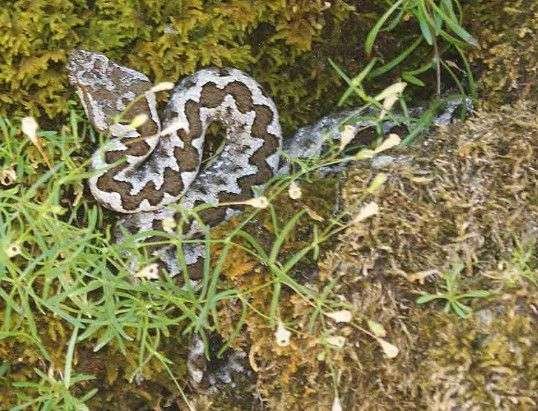
Long Nosed Viper is a European viper species and is considered to be one of the most dangerous vipers out there. Its venom is highly toxic, and paired with its long fangs and large size; it is not something to be easily trifled with. The skin of the snake ranges from slate gray to light brown, dotted with darker markings.
Human activity is the reason for the population decline of a lot of animals, and it is the same for the long nosed viper as well. The species is currently listed as strictly protected under Berne Convention.
- Common Names: Horned Viper, Nose Horned Viper, Sand Viper
- Scientific name: Vipera ammodytes
- Size: 50 centimeters (19.5 inches)
- Location: North-eastern Italy, Slovenia, Croatia, Bosnia-Herzegovina, Serbia, Montenegro, Albania, Kosovo, North Macedonia, Greece (including Cyclades), southern Austria, Romania, Bulgaria, Turkey, Georgia, Syria
16) Striped Blind Snake
Striped Blind Snakes are a species of small, worm-like bodies. Its skin is of different colors along its body, with it being pinkish brown at the front half and gray at the end half.
There are also 10 pairs of dark and light alternative stripes along the body. The snake’s eyes are covered by skin and are almost invisible, leading to its name.
For a period of time, striped blind snakes were thought to be extinct because of human activity. But after 172 years, it was rediscovered in Bukit Timah Nature Reserve in Singapore. Snakes are still a rarity in nature.
- Common Names: Lined Blind Snake
- Scientific name: Ramphotyphlops lineatus
- Size: 52.4 centimeters
- Location: Thailand, Singapore, Indonesia, west Malaysia
17) Blunthead Tree Snake
Blunthead Tree Snake is a species of mildly venomous snake mostly found in Mexico, Central America, and South America. The snake of this species is very thin and slender, with brown skin striped with beige. The snake has a blunt head and a pair of very large eyes.
Blunthead tree snakes are nocturnal animals and take a rest in a coiled position in shaded areas. It is also a rear-fanged snake, and its venom is not lethal to humans.
Though these snakes are still abundant in nature, there is a huge possibility of population numbers decreasing for them because of the huge amount of habitat destruction.
- Common Names: Fiddle String Snake, Mapepire Corde Violon
- Scientific name: Imantodes cenchoa
- Size: 30 – 35 inches
- Location: Eastern Mexico, Guatemala, Honduras, Belize, El Salvador, Nicaragua, Costa Rica, Panama, Colombia, Venezuela, Trinidad and Tobago, French Guiana, Brazil, Ecuador, Peru, Bolivia, Paraguay, and northern Argentina
18) Cyclades Blunt Nosed Viper
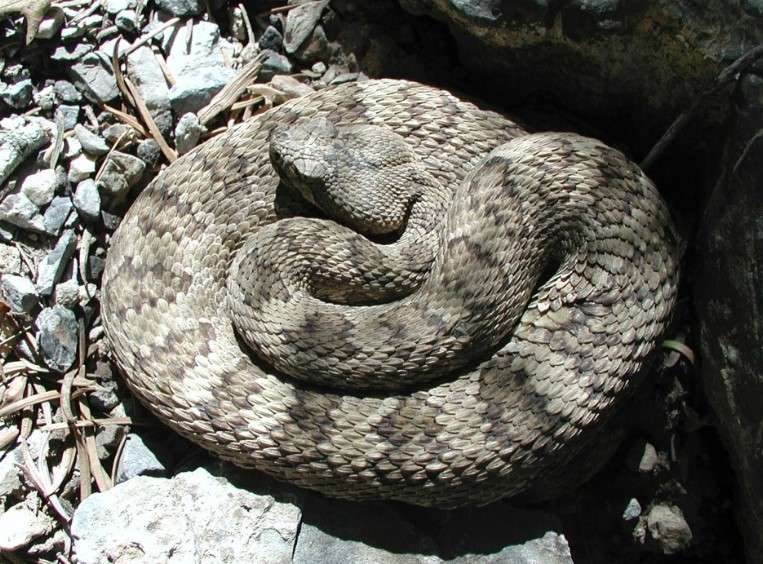
Cyclades Blunt Nosed Viper is another species of rare snake endemic to the Cyclades Archipelago. Like all vipers, they are deadly venomous, and their venom has been compared to a Russell’s Viper.
These vipers have blunt heads and reddish-brown colored bodies with dark stripes that run horizontally along their body.
Cyclades Blunt Nosed Vipers are very small in numbers, and their population has been found in only five islands. They are on IUCN’s Red List as an Endangered Species as well as in Berne Convention as strictly protected.
- Common Names: Milos Viper
- Scientific name: Macrovipera lebetinus schweizeri
- Size: 50 – 70 centimeters (20 – 28 inches)
- Location: Cyclades Archipelago in the Aegean Sea
19) Kikuzato’s Brook Snake
Kikuzato’s Brook Snake is a Japanese snake endemic to the Kumejima Island of Japan. The snake gets its common and species name from Kiyotasu Kikuzato, who collected the holotype of the snake.
This aquatic snake is moderately long with a slender body. Its skin is covered with parallel stripes of black and green.
Kikuzato’s Brook Snake is listed as Critically Endangered by IUCN. The reason for its population decline is due to water pollution, threats of capture, and the American Bullfrog, which predates the snake species.
- Common Names: Kikuzato’s Stream Snake
- Scientific name: Opisthotropis kikuzatoi
- Size: 15.45 inches
- Location: Kumejima Island of the Okinawa Island Group in Japan
20) Orlov’s Viper
We have another viper on this list of 20 rare brown and black snakes worldwide. Orlov’s Viper is a venomous species endemic to Russia. They are very hard to come across and are thus considered to be a rare species.
Orlov’s Viper has a relatively thick body. Its skin is reddish brown with continuous black diamond-like patterns along its body. Its natural habitats are forest, shrubland, and grassland in the Papai Mountains.
- Scientific name: Vipera orlovi
- Size: 50 centimeters
- Location: Krasnodar Territory in Russia
With this, we conclude this 20 rare brown and black snakes worldwide list. Let us know your thoughts about it, and if you’ve liked this articles, make sure to check our similar articles of interesting animal tidbits.
Also Read:
Anamika has a fascination with all living things. Being a Zoology student, she loves to know new interesting things about animals. She’s also a very keen fan of manga and anime. Writing is her passion, and writing about her favorite things is her boost of serotonin.
